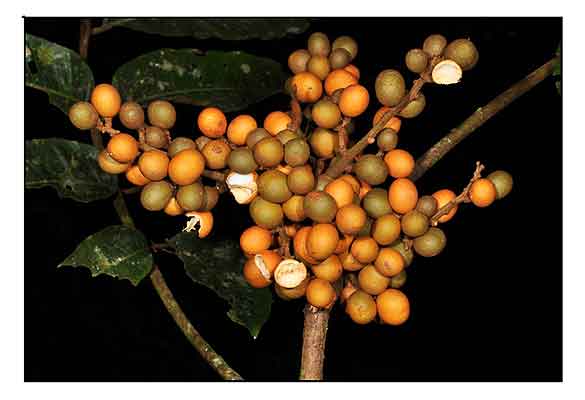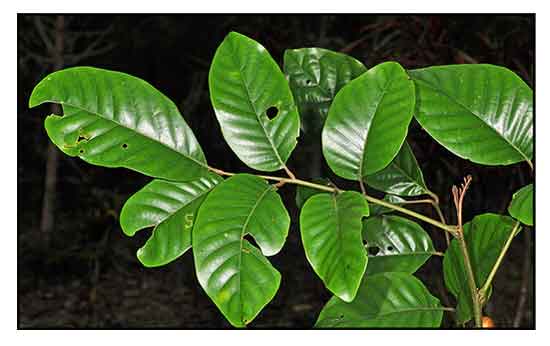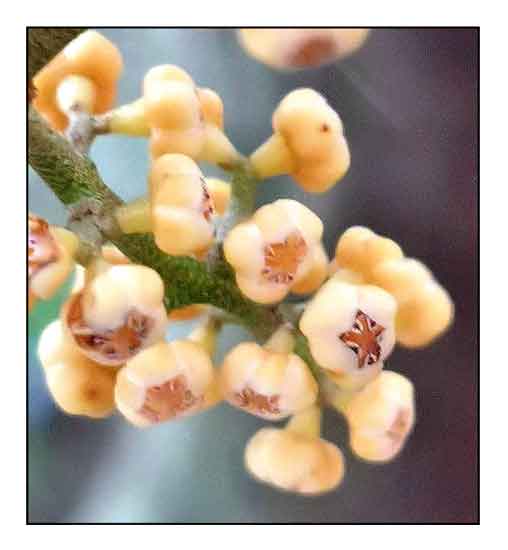 Gen info Gen info
- The genus Aglaia currently consists of 105 species, expected to increase as more is discovered. Within Malesia, the largest number of species is found in Borneo (50), followed by Peninsular Malaysia (48), Sumatra (38), the Philippines (35), and New Guinea (33). (3)
- In Taiwan, Aglaia rimosa is called 'Large-leaved aglaia", referring to its larger leaflets compared to two other native species, Aglaia elaeagnoidea and A. chittagonga; all three are imparipinnate.
(1)
Botany
• Aglaia rimosa is a shrub to medium-sized tree up to 30 m tall, bole up to 50 cm in diameter, buttresses up to 50 cm high, bark surface dark brown to greenish-gray, inner bark pink to dull red. Leaflets (3-)9-11(-15), subopposite, sometimes alternate, with 7-17(-20) pairs of secondary veins, above glossy and often rugulose, sometimes pitted and glabrescent, below sometimes pitted and with few to numerous radiating peltate scales with a dark orange-brown or dark reddish-brown center and a paler, entire to ragged margin, sometimes interspersed with few darker scales. Calyx with (4-)5 lobes, petals 4-5, anthers 5, rarely 6, style-head broadly ovoid or subglobose, with 2 small apical lobes. Fruit indehiscent, 2-locular. (1)
Distribution
- Native to the Philippines.
- Grows primarily in the wet tropical biome.
- Also native to Bismark Archipelago, Maluku, New Guinea, Solomon Is., Sulawesi, Taiwan.
(2)
- Common in secondary forests, along rivers and along the coast, on sandy clay or limestone, up to 1350 m altitude.
(1)
 Constituents Constituents
- Rocaglamide, also referred to as rocaglamide-A, is the eponymous member of a class of anticancer phytochemicals known as rocaglamides. Rocaglamides-A was first isolated in 1982 from A. elliptica. (6)
- Aglafolin is a heterotricyclic compound based on a 2,3,3a,8b-tetrahydro-1H-benzo [b]cyclopenta[d]furan framework substituted by hydroxy groups at positions C-1 and C-8b, a methoxycarbonyl group at C-2, a phenyl group at C-3, a 4-methoxyphenyl group at C-3a and methoxy groups at C-6 and C-8, a platelet aggregation inhibitor found in Aglaia elliptifolia and Aglaia odorata. (7)
-
Dichloromethane extract of leaves of A. loheri yielded spinasterol (1), trilinolein (2) and phytyl fatty acid ester (3). (see study below) (11)
Properties
-
Flower is fragrant, less than that of Aglaia odorata.
- Studies have shown anticancer, chemotherapeutic, antileukemic, platelet-aggregation inhibitory, possible maternal reproductive toxicity properties.
 Parts used Parts used
Bark.
Uses
Edibility
- Fruit is edible.
Folkloric
- No reported folkloric medicinal use in the Philippines.
-
In Papua New Guinea, decoction of scraped bark drunk daily for badly swollen stomach. (1)
Others
- Wood: Used for house construction. In Taiwan, the Tao people on Orchid Island use the wood to make boat rowlock or pillars for houses, and refer to the tree as refer to the tree as "maraboa" or "four limbs towards the sky". (4)
Studies
• Bioactive Flavolignans / Flavaglines: Flavaglines are formed by cycloaddition of a flavonoid nucleus with a cinnamic acid moiety representing a typical chemical character of the genus Aglaia. A wide variety of biological activities ranges from insecticidal, antifungal, antiprotozoal, anti-inflammatory, anticancer, and antiviral activities. (5)
• Aglafoline / Inhibition of Platelet Aggregation / Antileukemic Activity: Study in search for specific PAF (platelet-activating factor) antagonists (Ko et al, 1992) isolated aglafoline, which selectively inhibited PAF-induced platelet aggregation in washed rabbit platelets in a concentration-dependent manner. In a following study, coexisting rocaglamide was also tested for inhibition of platelet aggregation induced by adenosine diphosphate (ADP), arachidonic acid (AA), PAF, and collagen. Results showed 100 µg/ml of aglafoline completely blocked platelet aggregation caused by PAG, with no effect on ADP or collagen; rocaglamide was either inactive or showed only slight inhibition. Rocaglamide also exhibited significant antileukemic activity. Study has shown rocaglamide kills various leukemic cells through mitochondrial apoptosis pathway with only minor toxicities to normal lymphocytes. (5) Aglafolin is a heterotricyclic compound based on a 2,3,3a,8b-tetrahydro-1H-benzo[b]cyclopenta[d]furan framework substituted by hydroxy groups at positions C-1 and C-8b, a methoxycarbonyl group at C-2, a phenyl group at C-3, a 4-methoxyphenyl group at C-3a and methoxy groups at C-6 and C-8, a platelet aggregation inhibitor found in Aglaia elliptifolia and Aglaia odorata. (7)
• Cytotoxicity / Inhibition of Platelet Aggregation: Study isolated rocagloic acid, a benzofuran with a free carboxyl group at C-2, from the leaves of A. rimosa, which was shown to have significant cytotoxicity against a panel of human cancer cell lines. (5)
• Rocaglamide / Chemotherapeutic: Rocaglamide, also referred to as rocaglamide-A, is the eponymous member of a class of anticancer phytochemicals known as rocaglamides. Rocaglamides are secondary metabolites of the genus Aglaia. Its antitumor activity was first reported as far back as 1973, and rocaglamide-A was first isolated in 1982 from A. elliptica. Rocaglamide and a number of derivatives (didesmethylrocaglamide) are currently used as chemotherapeutic agents in treatment of various leukemias, lymphomas, and carcinomas, and as adjuvant in treatment of certain chemotherapy-resistant cancers. (6)
• Cytotoxicity Against Human Colon Cancer Cells (HCT116) / Bark: Study evaluated the cytotoxic activity of bark extracts from Aglaia loheri against human colorectal cancer cell line HCT116 using MTT assay. The hexane bark extract (ALBH) and ethyl acetate (ALBEA) partitions and most of the VLC and GCC fractions showed high to moderate cytotoxicity. Reduced mitochondrial membrane potential and the presence of genome fragmentation in treated cells confirmed the apoptosis-inducing effect of the GCC fraction ALBEA9.2. Results showed the bark extracts showed highly selective cytotoxic activity against HCT116 cell line and potential for ALBEA9.2 as apoptosis inducing anticancer agent. (8)
• Effect on Maternal Reproductive Performance / Leaves: Study evaluated Aglaia loheri for toxicity and effects on maternal performance and fetal morphology on inbred ICR mice using oral doses of 5 and 10 mg/ml concentrations from 8th to 15th days of pregnancy. Dissection showed significant differences in maternal reproductive performance in measures of gestation index, % dead implants, % females with resorption, % resorption and % fetus with morphological abnormalities A. loheri treatment with 10 mg/ml extract with or without vitamin A, and 5 mg/ml extracts resulted ni 100% resorption. Significant weight losses in mice at higher doses of A. loheri plus vitamin A suggest toxicity and synergism with vitamin A. Results advise caution must be taken when using the extracts during pregnancy due to possible toxicity and teratogenicity. (9)
• Cytotoxicity Towards Sensitive and Multidrug-Resistant Cancer Cells: Bioactiveity-guided fractionation of A. loheri extracts yielded a cytotoxic isolated a phenolic ester, Maldi 531.2[M+H]+, which was investigated for in vitro cytotoxicity toward human CCRF-CEM leukemia cells and MDR subline, CE M/ADR5000. Results showed MALDI531.2 was cytotoxic towards both CCRF-CEM and CEM/ADR5000 cells with IC50s of 0.02 and 0.03 µM, respectively. Results suggest potential as anticancer drug candidate with modes of action including reduction of mitochondrial membrane potential and induction of apoptosis. (10)
• Cytotoxicity Against Colon Carcinoma (HCT 116) / Leaves: Dichloromethane extract of leaves of A. loheri yielded spinasterol (1), trilinolein (2) and phytyl fatty acid ester (3). Compounds 1, 2, and 3 were evaluated for cytotoxicity against colon carcinoma (HCT 116) using MTT assay. The compounds exhibited moderate cytotoxicity with IC50s of 40.52, 46.73, and 40.06, respectively. (11)
• Substrate Specificity of Maldi 531.2 Towards P-gp in MDR Cancer Cells: Multidrug resistance (MDR) is a major contributory factor in the failure of chemotherapy. Study evaluated the effect of Maldi 531.2[M+H]+ on P-gp ATPase activity. To test the effects of Maldi 531.2[M+H]+ on MMDR activity, Maldi 531.2[M+H]+ was combined with a potent P-gp substrate such as verapamil. Depending on certain drug concentrations, stimulation and inhibition of MDR activity were observed suggesting biphasic reactions, possibly cooperative stimulation and competitive inhibition. (12)
• Aglaforbesin Derivative / Cytotoxic and Apoptotic on HCT116 Colorectal Cancer Cells: Bioassay-guided fractionation evaluated an A. loheri leaf extract by MTT assay on human colorectal carcinoma cells. An HPLC isolate, an aglaforbesin derivative (AFD) exhibited potent cytotoxicity against HCT116 (IC50 1.13 µg/mL) and high selectivity on HCT116. AFD-induced toxicity to HCT116 is possibly via stimualtion of apoptotic signaling pathway via caspase 3/7 activation and DNA fragmentation independent of mitrochondrial membrane depolarization. The AFD selective cytotoxicity and apoptotic activity to HCT116 suggest potential as an anticancer drug lead. (13)
Availability
Wild-crafted. |

![]()




 Constituents
Constituents
